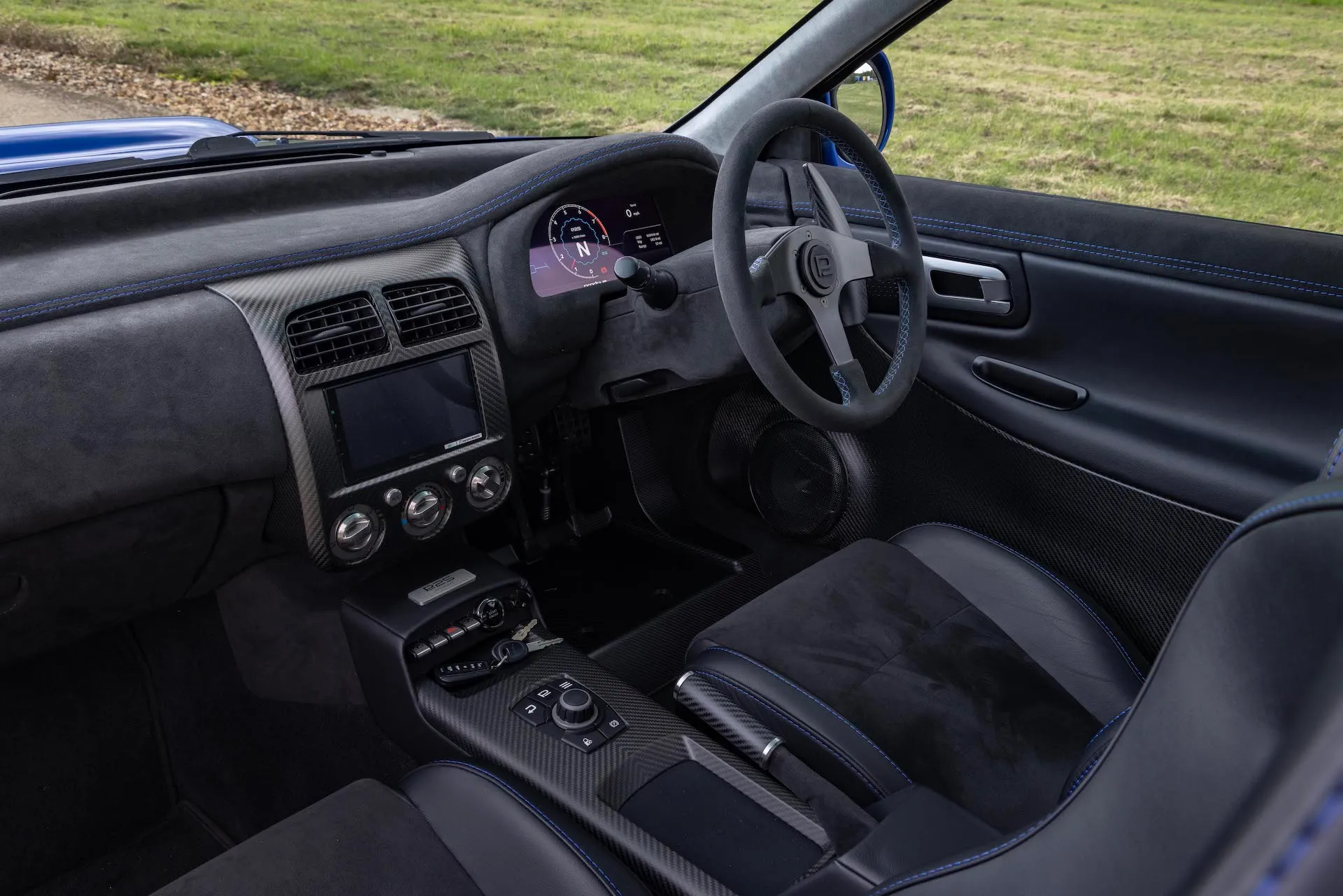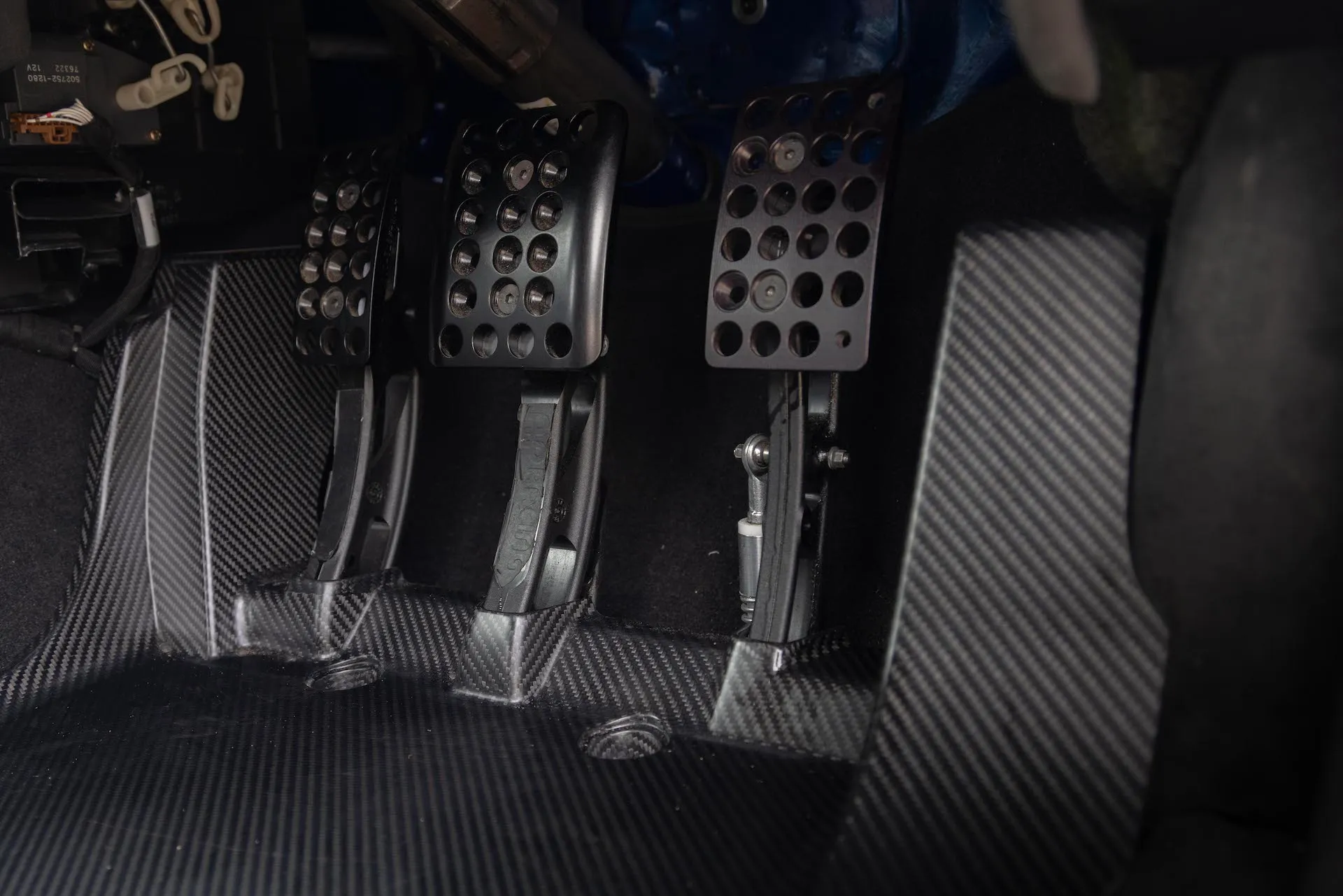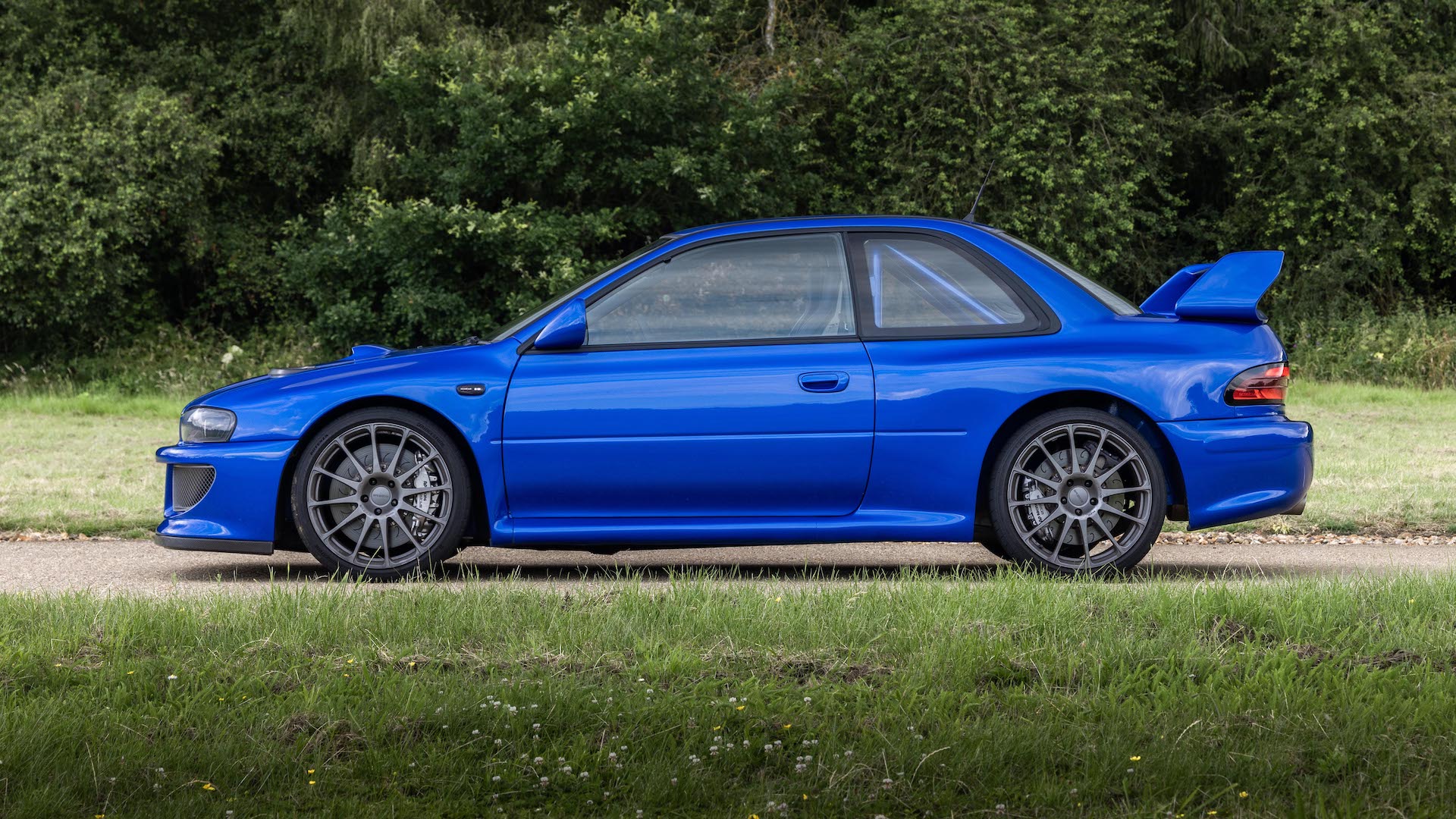I was just 10 or 11 years old when Subaru was kicking ass in the World Rally Championship. Between 1995 and 1999, heroes like Colin McRae, Tommi Mäkinen, and Carlos Sainz piloted their Subarus, Mitsubishis, and Fords to headline-grabbing victories across the globe. As a teenager, Gran Turismo reignited that passion by allowing me to “drive” rally icons on virtual race tracks, leading me to believe that I could really trail-brake and powerslide my way around a real one. As it turns out, that’s not really the case.
“When the rear of the car shakes like that it wants to break loose, but you must keep your foot down so the center diff can do its thing,” the Prodrive engineer in the passenger seat told me. “Okay,” I answered. In reality, though, I was thinking, “Thanks, but no thanks.”

After a couple of installation laps at Millbrook Proving Ground in the U.K. behind the wheel of a modified 2023 Subaru WRX, I found myself strapped to a mind-numbingly expensive recreation of the iconic Subaru Impreza 22B STI. It’s called the Prodrive P25, and to add one to your collection you had to pony up around $600,000—give or take a few thousand for customization. I say “had” because they’re all sold out.
Now, if you’re wondering who would ever spend that kind of coin on a new replica of an old race car, re-read my first paragraph. I’m precisely the kind of enthusiast Prodrive—a motorsport and engineering outfit responsible for some of the world’s winningest race cars—targeted with this thing. Someone who grew up idolizing rally drivers and then pretended to be them during PlayStation’s golden years. The only exception is that when I became an adult, I went into blog writing, not hedge fund management.




Prodrive P25 Specs
- Base price: $600,000 est.
- Powertrain: 2.5-liter turbocharged flat-four | 6-speed sequential | all-wheel drive
- Horsepower: 434 @ 4,000 rpm
- Torque: 457 lb-ft @ 3,000 rpm
- Seating capacity: 2
- Curb weight: 2,500 pounds
- Quick take: What rally dreams are made of.
- Score: 10/10
“Damn, I Feel Alive”
I hopped in the right-hand-drive P25 and adjusted my seat and steering wheel. Everything inside the cabin is either carbon fiber or Alcantara, with the exception of the roll cage, of course. That’s why it only weighs 2,500 pounds. Everything, and I mean everything is period-correct here. Even the keys look like they did in the original 22B back in 1998. It’s awesome and hilarious at the same time.
I pushed the clutch in and pressed the engine start button. The 2.5-liter turbo flat-four boxer motor plucked from a 2018 STI roared to life in the same way an unrestricted race car would. It’s not quite to the point where you need earplugs, but close. I let the clutch out and the car began shaking as if it were going to stall. I had been briefed that the automated clutch only had about an inch of travel and, like a race car, featured anti-stall, so the shaking was normal until about 20 mph. It’s as if the car was shaking my hand saying, “Ready? Let’s go!”


Nothing prepares you for that first hit of acceleration and the brrrrraaaaaaap crescendo before you pull on the paddle. This isn’t just any 2018 STI engine. Sure, it started out that way, but the final product is far from it. Completely rebuilt by Prodrive with a race-tuned anti-lag system (and tons of other bespoke components), it produces 434 horsepower and 457 lb-ft of torque. The transmission is a six-speed sequential box with helical gears from XShift, the same company that builds WRC transmissions. It puts the power down via an active center differential and front and rear limited-slip differentials. The end result is zero to 60 mph in just 2.8 seconds. And no, that’s not on slicks.
I’m in third gear as I approach the first corner, a blind uphill right-hander that quickly turns left after the crest. I downshift into second and realize that was unnecessary, so I shift back into third. The P25’s sequential gearbox worked the same way as the shifter karts I raced growing up. There’s only one paddle on the right that you pull to upshift and push to downshift. The clutch is only used to shift from neutral into first gear. Unlike the karts, however, this one was pneumatically assisted, so shifts happened immediately and felt like you’d been kicked in the chest by a horse.




It took me all of 30 seconds to understand why this car cost so much. It’s a race car, not a supercar. And like a race car, it can chew you up, spit you out, and then laugh at you for good measure.
I began my second lap by momentarily thinking I was going to crash a $600,000 car. I saw it play out in my head: I overcooked the entry and ended up on the wet grass, I slid uncontrollably until a tire barrier put an end to my misery. My left foot was hard on the brake pedal when, suddenly, THERE! the brakes finally showed up. “Yeah, the brakes don’t have much assistance,” muttered the engineer riding shotgun.
Third lap. The track’s final corner was a very fast right-hander that led to a not-quite-straight straightaway. I worked my way up the gears, giggling each time I pulled on that lovely paddle. Psht, psht, psht. The pneumatic assist made me feel like Colin McRae, and the sound of the turbo and escalating revs only exacerbated that feeling. I held onto fifth gear for a few seconds before it was time to brake hard for the first corner again. This time I braked a little sooner and much harder while also making sure I was doing so in a straight line. Downshift twice going into the hill, release the brake, hit the apex, then back on the throttle coming down the hill.

The little right-hand kink that followed was best taken hard and a bit dirty. By that I mean a light tap of the brakes, a yank on the wheel, and make the tires eat a bit of grass. I heard some gravel hit underneath the car. “Atta boy,” I said to myself. During subsequent laps, I realized I only needed to downshift once at the first corner and keep it in fourth until the last one.
The following section was my favorite part of the track. I held the P25 near redline in fourth gear and made it dance over a couple of esses with elevation changes. Not sure how fast I was doing through there, but probably around 70-75 mph. It took every ounce of strength to turn the heavy wheel and use every inch of track in order to keep a steady pace. Once out of the esses, hard gas and shift into fifth gear before lining up the car for another little right-hand kink that led to the main straightaway.
After a few laps, I came in to catch my breath. It dawned on me that I hadn’t been ready for what the P25 threw at me. I couldn’t remember the last time I had been manhandled by a car that badly. At some point, I was legitimately scared that it was too much car. In retrospect, my feelings came from a place of anger that I couldn’t squeeze more out of the P25. I was angry I wasn’t actually Colin McRae.





I kicked my shoes off and went out for another track session, they were just too bulky for the beautifully milled pedals. I felt more confident behind the wheel this time around, and knowing the track better certainly helped.
Braking hard for the first corner, I smoothly guided the car to the top of the hill and downshifted only once this time around. The car went up and quickly down in what felt like a seesaw. I gently squeezed the throttle and pulled left to position the car for the next corner. I clipped the kink and gave it the English breakfast beans as I blasted out of it. The engine noise filled the cabin—and my ears. It was tempting to carry more speed into the essses, but I refrained. “Smoother,” I told myself, not faster. Precision, not speed.
I threw the car around the esses like Hulk Hogan bodyslamming a middle schooler into a locker. The P25 darted from one side to another with force and precision. The steering was the purest of any road-legal car I’d ever driven. The Ferrari 430 Scuderia has been relegated to the No. 2 spot on my personal list. None of the car’s components—not even the tires—seemed to struggle, not even a little bit.

It was at this section of the track where the P25 really wowed. (This facility, by the way, is where James Bond’s famous DBS crash in Casino Royale was filmed.) Imagine setting the cruise control at 70 mph while going in a straight line, but then that straight line morphs into a slalom and you can’t turn off the cruise control. Fun, eh? I could’ve slowed down, sure, but what’s the fun in that?
I lined the car up coming out of the final corner, took a few deep breaths, and focused on nailing my last couple of laps. I cracked the throttle a bit more this time and delayed my braking point by another 10 feet at the first corner. The car just kept on giving me more and more. It was an intoxicating and rather dangerous game to play with a ridiculously expensive car that’s not mine, but I relished the challenge.
Why? Simple, because most supercars nowadays can be driven by children. From the latest Ferraris to McLarens and Astons, they can all be subdued at the push of a button. Not the P25. This thing is a bucking bronco, and damn does it make you feel alive.

Why Is It So Expensive?
I asked this very question to someone who’s been around from the very beginning—as in, since Prodrive built and ran those WRC-winning Subaru Imprezas in the ’90s.
“It’s simple,” said Prodrive R&D Director David Lapworth. “Grab all the development of the components, the manufacturing, the benchmarking, the thousands and thousands of man-hours, the thousands of laps of testing, all the research that went into this project, and divide it by 25. That’s it, just 25. That’s why.”
[Ed. note: To save you a trip to the calculator app, $600,000 times 25 is $15 million. -CT]
Of course, it’s also because a ridiculous amount of customization went into every one of those 25 units. For example, one of the three units that came to the States had to have a custom ECU to help it run better at altitude and on 91-octane fuel due to Utah’s unique characteristics. Some were right-hand-drive and some were left-hand-drive. Some had full cages and others half, some had normal seats while others had carbon fiber buckets.




Either way you cut this shepherd’s pie, the result is the same. The Prodrive P25 is what other supercars simply can’t be in this day and age. This is a car that requires skill to tame. It’s not built to please the Instagram-loving nouveau riche. It’s quite cool but not exactly pretty. In fact, if someone broke into a collector’s garage and saw it parked among a few Ferraris and Lamborghinis, they’d steal the others without knowing the little Subaru was the most expensive of the bunch.
And man, there’s just something really cool about that.
Email the author at jerry@thedrive.com
